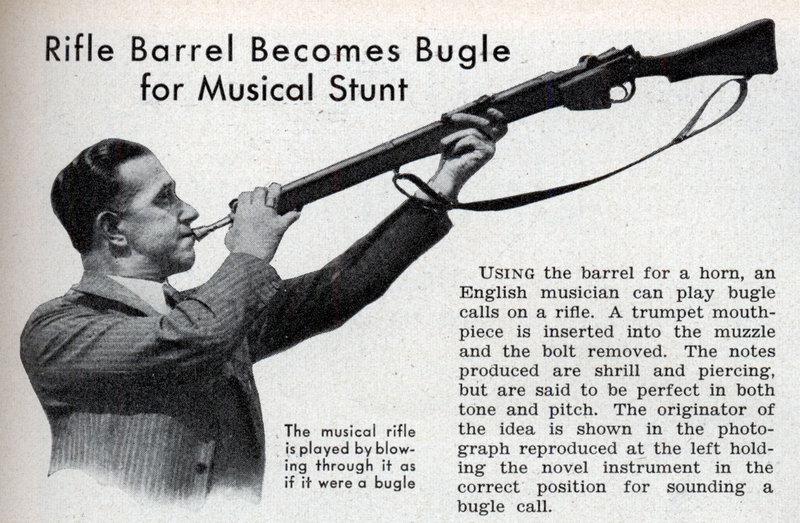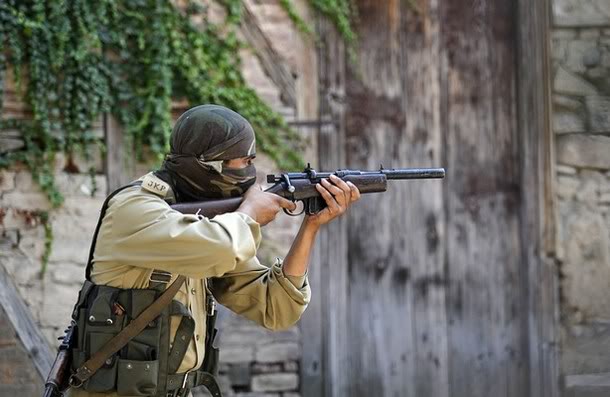-
FREE MEMBER
NO Posting or PM's Allowed

Just how far can you modify an enfield?
Here's a pic of something interesting at a local gunshow, the vendors thought that several were produced like this locally in Auckland. It looks like a no4 receiver, I recognize a rear sight ramp groove, and of course a number 4 bolt. That striker knob has me baffled, the knob is familiar but the body like nothing I've seen on an enfield. That rear tang is something else too.
It sold quickly, for about 300, so there must have been some idea that this was desirable.
Information
 |
Warning: This is a relatively older thread
This discussion is older than 360 days. Some information contained in it may no longer be current. |
|
Last edited by RJW NZ; 04-03-2011 at 07:49 PM.
-
04-03-2011 07:47 PM
# ADS
Friends and Sponsors

-
I might have bought something like that just for the "nifty!" factor. The machining and mods are well executed IMHO.
Союз нерушимый республик свободных Сплотила навеки Великая Русь. Да здравствует созданный волей народов Единый, могучий Советский Союз!
-
-
-
FREE MEMBER
NO Posting or PM's Allowed

In the first Crocodile Dundee film I remember Paul Hogan using an Enfield with a thumbhole stock. Cant remember if it was scoped or not, but was a pretty cool looking Enfield to me. I've also checked the Mad Max series of movies for Enfields but never did spot one. Australia seems to have produced lots of mods as Enfields were a principle sporting arm for them, just as the Springfields and 1917 Enfields were for the U.S. before the flood of affordable commercial rifles hit the market in the mid 1960's.
seems to have produced lots of mods as Enfields were a principle sporting arm for them, just as the Springfields and 1917 Enfields were for the U.S. before the flood of affordable commercial rifles hit the market in the mid 1960's.
-
FREE MEMBER
NO Posting or PM's Allowed

This is the most practical enfield mod...

-
Legacy Member


Wonder if he cleaned the bore after the concert
-
-
Legacy Member

It's funny how thing go around in circles.
Remember that the original Lee was fitted with a one-piece stock, barrel mounted sights and no charger system. The illustrated rifle cheerfully undoes over a century of work.
Added to that is that the various home-made versions of this that I have seen up close, including the rare and exotic Canadian J5550 experimentals, all seem to miss one fundamental thing about the Lee Enfield action: the rear-locking factor. Because of this key feature, the action does not compress from the breech ring rearwards, but pushes the breech ring forward. The mechanics are utterly different from anything Mauser-related.
J5550 experimentals, all seem to miss one fundamental thing about the Lee Enfield action: the rear-locking factor. Because of this key feature, the action does not compress from the breech ring rearwards, but pushes the breech ring forward. The mechanics are utterly different from anything Mauser-related.
The J5550 was an attempt to shave as much weight off the rifle as possible: All very commendable until you have to fire the thing.
Because the bolt locks at the rear, recoil forces are transmitted from these rearward features to the firer's shoulder. In a Lee Enfield, this is quite well done by means of having the butt attached to the receiver by the tapered socket system held together by the sturdy stock bolt.
In the J5550, the barreled action weighs about 25% less than the original. The designers seemed to think that the recoil from this structure, caused by the standard .303 ball round, could be reliably transferred via a wafer-thin "lump" mated into a stock styled after a toothpick: Another triumph of optimism over experience.
Does anyone have one of Charlie Epps modifications for comparison?
My thinking for those who absolutely must do this sort of thing: If the socket were trimmed and adjusted to form a "leg", a la the recoil strut at the rear of an SKS, things might be more robust and functional.
However, the spindly construction of the wrist of the J5550 stock would not last long when subjected to leaping out of aircraft, or using the rifle with a bayonet or as a club, as soldiers are wont to do on occasion.
My trusty old Sportco SMLE sporter in .303-25 performs very nicely on game from foxes to deer, even with its slightly cheesy commercial butt and "sporterised" ex-mil fore-end bolted onto the action. The only annoying thing is that the "manufacturers" decided that the charger bridge had to go in the interests of "style". Thus, an aluminium side-mount had to be fitted for a scope.
-
Thank You to Bruce_in_Oz For This Useful Post:
-
The original Lee, brought to England for trials is housed at Warminster. It is indeed a one piece stock but broke at the wrist quite shortly during its trials during bayonet fighting part of those trials. As a result, the adopted Lee Metfords and the now famous SMLE's were all two-piece. I don't know why they reverted to the old one-piece stock for the P13's. But suffice it to say, when the P'14's and 17's were modified for grenade firing, the wrist of the stocks were considered a weak point were wire or cord-bound.
for trials is housed at Warminster. It is indeed a one piece stock but broke at the wrist quite shortly during its trials during bayonet fighting part of those trials. As a result, the adopted Lee Metfords and the now famous SMLE's were all two-piece. I don't know why they reverted to the old one-piece stock for the P13's. But suffice it to say, when the P'14's and 17's were modified for grenade firing, the wrist of the stocks were considered a weak point were wire or cord-bound.
My take on the rifle in RJ's picure is that given a hacksaw and a set of oxy bottles, anything is possible
-
-
FREE MEMBER
NO Posting or PM's Allowed

Elwood Epps Company in Ontario, Canada , did many modifications on Lee Enfields with a one piece stock. This was done by machining the butt socket to a thinner profile, and adding a tang (on the ones that I have seen.) He would also convert the No. 4 and the P-14 rifles to a blown out case known as the .303 Epps.
, did many modifications on Lee Enfields with a one piece stock. This was done by machining the butt socket to a thinner profile, and adding a tang (on the ones that I have seen.) He would also convert the No. 4 and the P-14 rifles to a blown out case known as the .303 Epps.
The striker know looks like the early Canadian or Savage No. 4 Mark 1 knob. These are very scarce, and command a high price here in Canada from people who want to restore their early No. 4 Long Branch rifles to original.
.
-
Legacy Member

Gas or Rubber Bullet conversion (no one has yet decided on the calibre / modification)

Mine are not the best, but they are not too bad. I can think of lots of Enfields I'd rather have but instead of constantly striving for more, sometimes it's good to be satisfied with what one has...
-
-
Thanks for posting! Did you get any more photos of this oddity before it sold?
1) It reminds me a bit of the M1899 Remington Lee, the last of the American Lees(photos attached). In America, the Lees always kept the one-piece stock. The M1899 had front-locking lugs, thus sidestepping the criticism most often heard against the Lees. I suspect that with a bit more development, this version could have become a successful challenger to the Mauser. However, the US was still in love with lever actions in this era and bolt actions would not become popular among hunters until after WWI.
2) Bruce, where can we learn more about the Canadian J5550 experimental rifle?
J5550 experimental rifle?
3) Peter, do you know if there are any written records of the committee that made the decision to go with the 2-piece stock for the Lee Metford? I would love to read in their own words the considerations they made.
.
.
Researching Lee Speeds and all commercial Lee Enfields. If you have data to share or questions, please send me a PM.
-















 Register To Reply
Register To Reply














